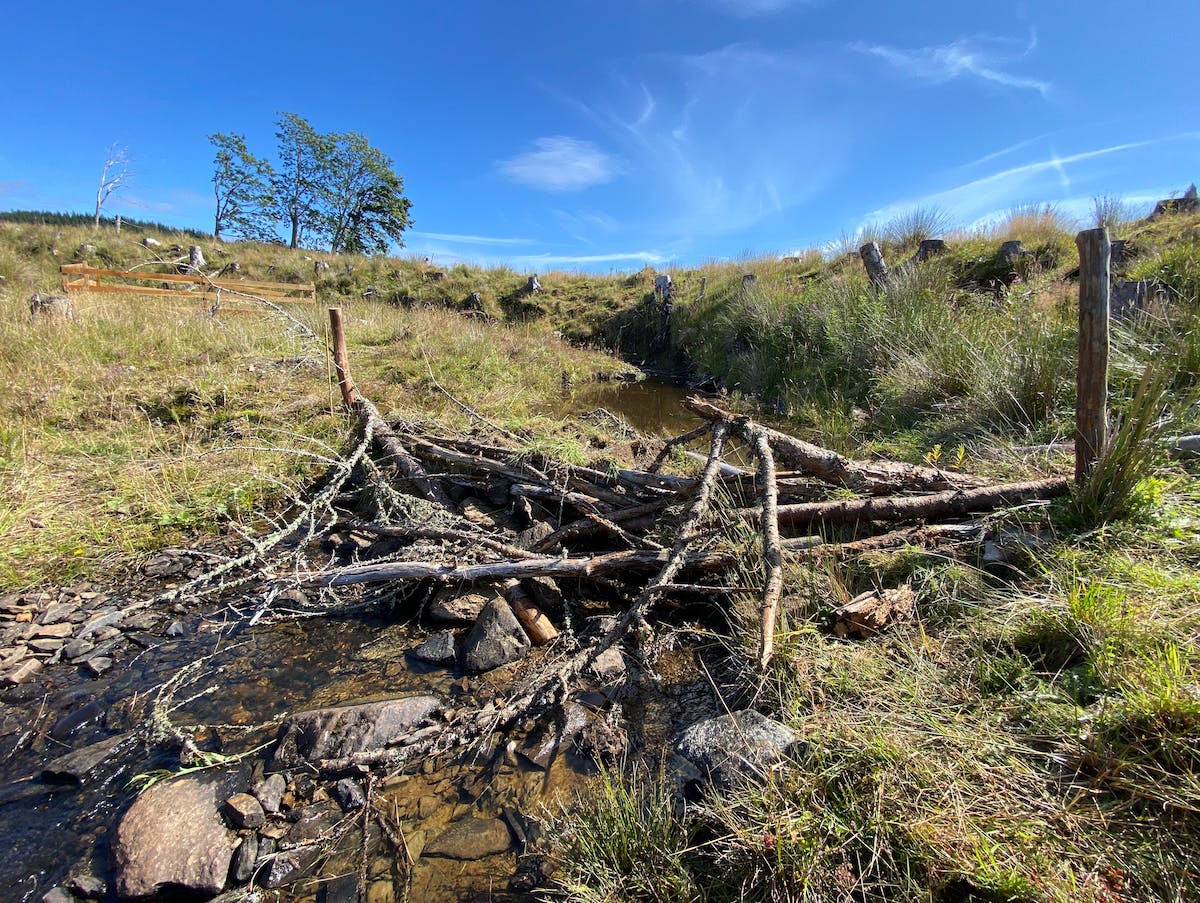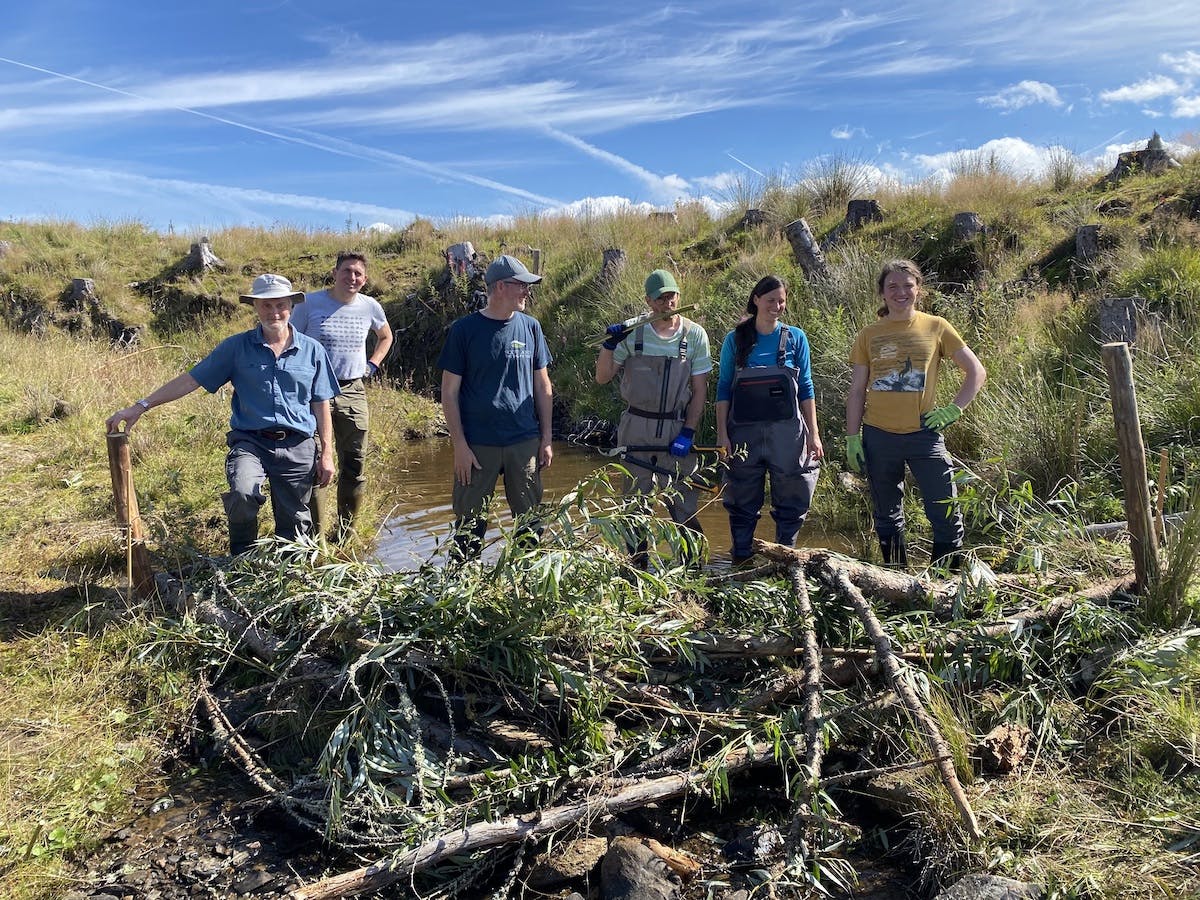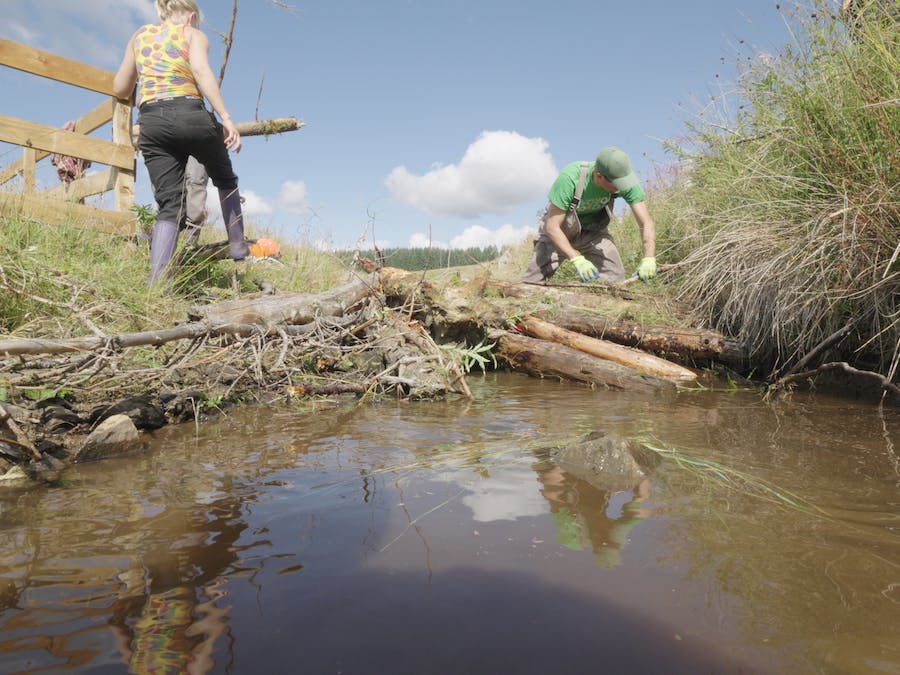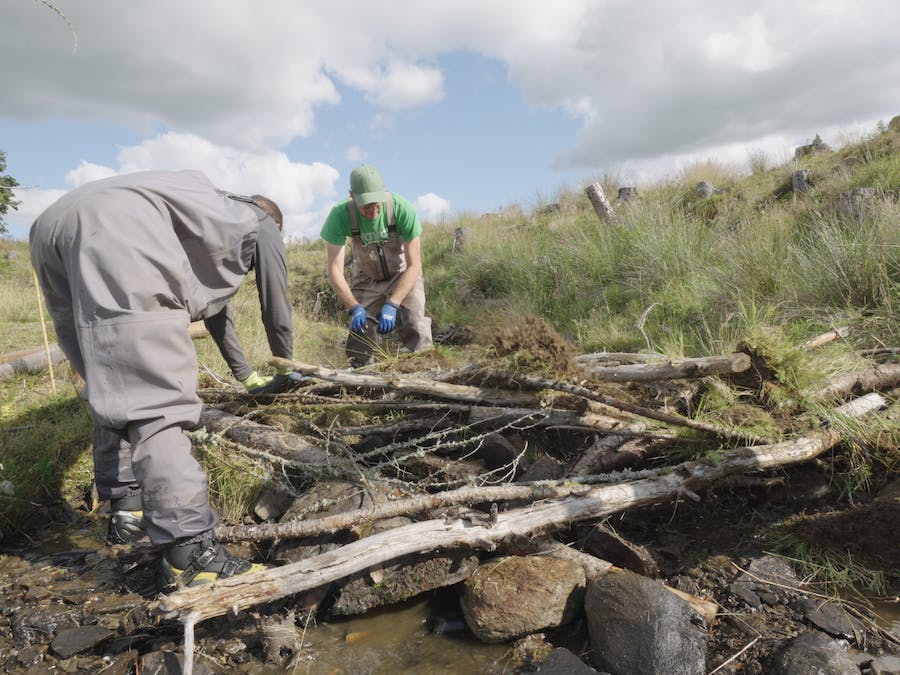- Management Plan
- Final Report
- Total budget: £18,379
- Budget spent: £18,379
- Status: Post-Implementation Monitoring
Beavers have rightly claimed a lot of accolades in the recent rewilding movement for their central role in restoring riparian areas. The dams they engineer create habitats, filter water and help mitigate flood damage and droughts. For degraded riparian areas devoid of trees and beavers, artificial structures called Beaver Dam Analogues (BDAs) are being used to mimic the effects of beaver dams. This is the case for our latest project in Scotland at Glassie Farm, a member of the Northwoods Rewilding Network (NRN). Habitat degradation, pollution and rising water temperatures are threatening a host of important native species. In partnership with River Revivers, we’re building BDAs and planting native trees and scrub to create habitat, help improve water quality, stabilise water temperature and mitigate flood damage.
Project Timeline
June 2024
4 new fake beaver dams are constructed with additional reinforcements to replace the dams that were washed away in extreme storms last winter.
read moreOctober 2023
Unusually high levels of rainfall caused severe damage to the dams. We are currently planning to rebuild the dams next spring using new methods of reinforcement.
read moreRepairing Scotland's Riverine Ecosystems
Glassie farm is part of the growing wave of landowners in Scotland who are committing to nature restoration initiatives whilst driving community engagement. Situated in 90 acres (36 ha) of pasture and woodland in Aberfeldy, the farm is progressing in efforts to transform former agricultural land into more biodiverse habitats that attract visitors to stay on the property. Ongoing habitat restoration so far has included planting native trees, creating scrapes for wading birds and increasing deadwood. The focus is now turning to the riparian area where there is an opportunity to enhance biodiversity and help mitigate the impacts of flooding downstream.
Running through the farm is a burn (watercourse) that flows through a treeless area. The burn runs unimpeded to the main stem (River Tay) and so during peak flows it can contribute to flood waters downstream. At present, the conditions are not suitable for beavers, whose dams reduce the speed of water flows and provide habitats for numerous species. The absence of trees (a food source) and being a relatively narrow, shallow and fast running burn are unfavourable conditions for this industrious ecosystem engineer to be present. This therefore presents an ideal chance to trial the use of artificial beaver dams to see if they can help change the landscape to benefit biodiversity and the local community.
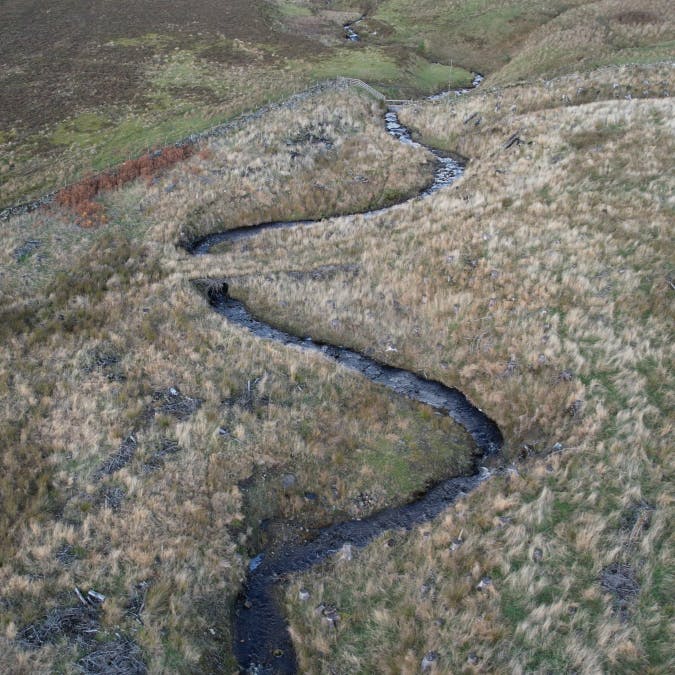
The Cost of Inaction
Rising water temperatures due to climate change and a lack of tree cover is threatening Scotland’s watercourses. Glassie Farm's riparian areas is one such example where no shade affects warming waters. As temperatures rise, fish and other wildlife are exposed to increased thermal stress.
Further to this is the issue of water quality. The burn runs through a conifer plantation upstream of our site where large amounts of pine and spruce needles accumulate. These needles are acidic and as they decompose the acidic compounds leach into the river, lowering the pH. A low pH level in the water is detrimental to wildlife, affecting an animal’s ability to swim, eat, reproduce and grow. Impacted species include insects such as stonefly (plecoptera sp.), mayfly (ephemeroptera sp.), non-biting midge (choronomid sp.), caddis flies (trichoptera sp.) as well as brown trout (Salmo trutta), European eels (Anguilla anguilla) and Freshwater Pearl Mussels (Margaritifera margaritifera).
The above list contains several endangered species that fulfill vital roles in the ecosystem. European eels (critically endangered internationally) embark on miraculous migrations where they are a vital nutrient flux to and from the Sargasso Sea as well as being both predators and scavengers and a preferred prey species for otters, osprey and heron. Freshwater Pearl Mussels (endangered internationally) are large filter-feeding bivalves that have an impact on the crucial processes of nutrient release, particle processing and sediment mixing. These keystone species are integrated in complex interactions and losing them would adversely affect balance on the riverine ecosystem.
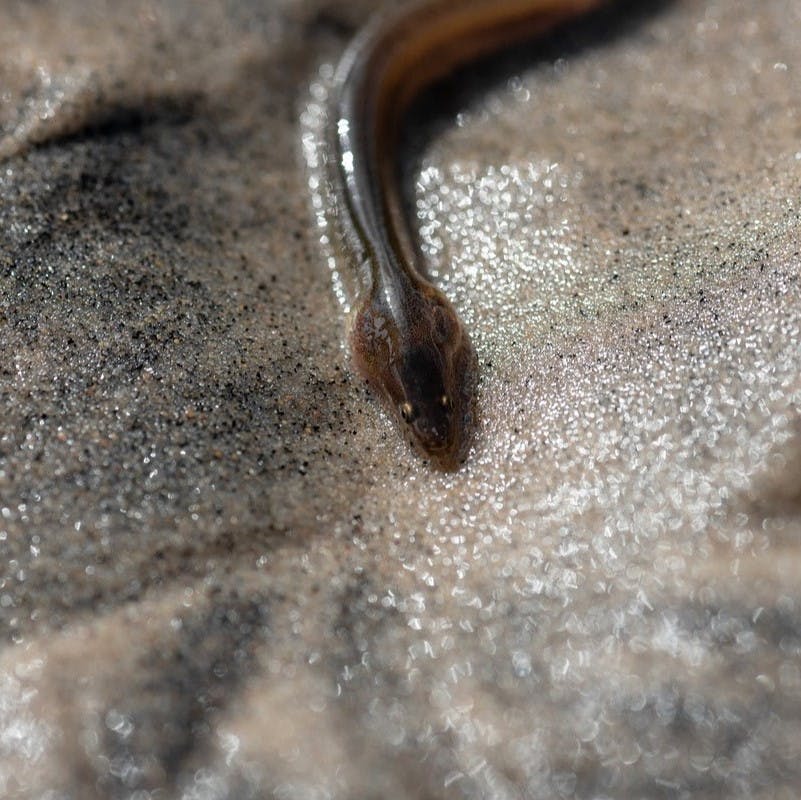
Beaver Dam Analogues
This project intends to enrich the ecological value of Glassie Farm’s riparian area and simultaneously mitigate flood damage through several measures. The installation of BDAs is one of these measures.
BDAs are man-made structures aimed at imitating the design and function of natural beaver dams. They are used as a non-intrusive, cost-effective tool for river restoration.
BDAs vary in materials and form but generally, they are constructed by stakes/posts knocked into the substrate (3-4 ft deep and above) of a stream with natural materials weaved between the stakes/posts and compounded with sediments, soil or rock.
Like their natural counterparts, they are not designed to be permanent structures but they should stay in place for a few years. When they give way, the materials will be spread downstream and will contribute to the woody structure in the system. Such deposits of wood into the system help build resilience as well as dynamism.
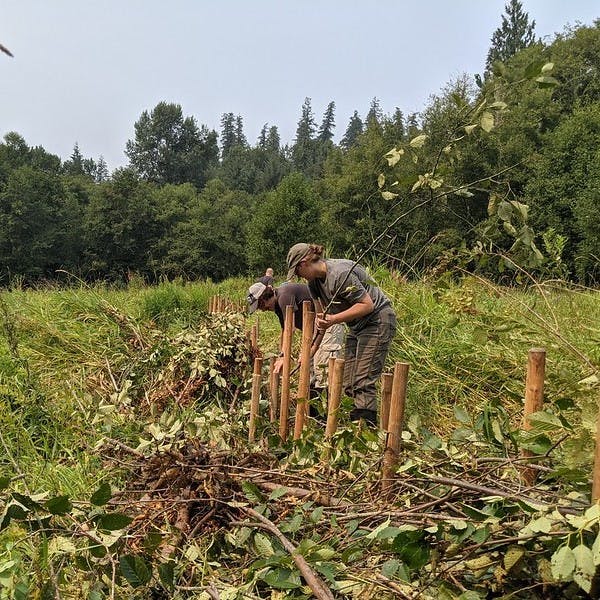
How BDAs could improve Glassie Farm
The desired outcome of using BDAs at Glassie Farm is to promote hydrological and ecological stream processes that natural beaver dams would, such as overbank flooding, habitat creation, water filtering and flood and drought control.
Reestablishing Riparian Habitats
The input of woody materials into a riverine system helps water channels reconnect to floodplains and enhances healthy ecological processes. Having BDAs in Glassie Farm’s riparian system could recover a natural flooding process. BDAs would retain surface water in pools that could subsequently lead to overbank flooding. In this process, slow flowing pools and new wetland habitats suitable for many microorganisms, insects and juvenile fish would form. It is likely that freshwater shrimps and the critically endangered eels would inhabit the BDAs at Glassie Farm. Naturally, by restoring populations of invertebrates and fish, there will be an increase in abundance of life further up the food chain too. More bats and birds will flock to feed on invertebrates and fish populations. The creation of new pools and wetlands would also attract a range of amphibians such as frogs and newts to feed and reproduce.
Water Filtering
It’s expected that a gravel filter will develop on the upstream side of the BDAs. Eventually, this could become a bio-filter capable of removing the nutrient load from the water resulting in cleaner flowing water downstream. This ‘trickle filter’ effect could help improve the water’s pH level and therefore help fish and aquatic invertebrates.
Alleviate Floods and Drought
Natural beaver dams are a natural flood management method. BDAs are designed to function much the same way by interrupting and slowing peak flows into a main river. During high rainfall events, BDAs would help alleviate floods by pushing water sideways onto floodplains and storing water upstream. Through the same process, the retained water would help maintain base flows during droughts.
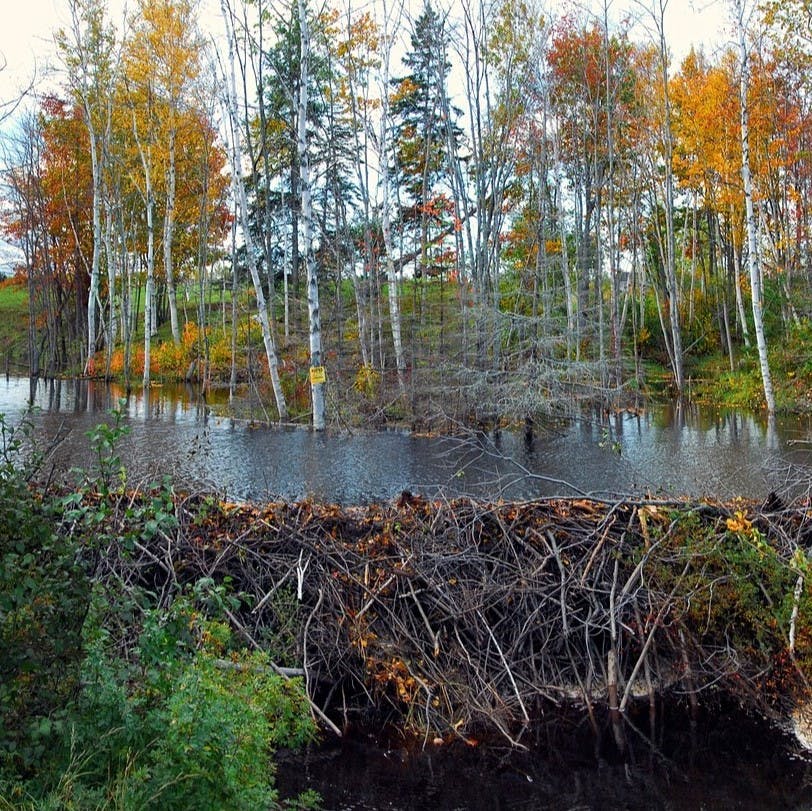
Our Project
Through our project partnership with River Revivers, we have set out to achieve the following objectives at Glassie Farm.
- Increase in-stream habitat/woody structure: the presence of BDAs and riparian trees will provide food and shelter for fish, invertebrates and amphibians. These structures are likely to accumulate more woody structures as natural material is washed into the stream and becomes trapped against the BDAs. Gradually, some of this woody material will release and travel downstream contributing to the three key hydrological processes of a healthy watercourse; erosion, deposition and transport. Increasing the overall woody mass of the system is a necessary process which helps build the river’s resilience and dynamism. The trees and scrub we are planting will also add to the input of terrestrial and riparian wood over time. Species to be planted include downy birch, alder, willow, rowan, hawthorn, and aspen.
- Reduce water temperatures: riparian planting of native broadleaf trees within 5 separate fenced squares will (in time) produce shade for the river and provide food for insect in the form of leaf litter.
- Mitigate flood damage & droughts: by manually erecting BDAs in the streams this should interrupt and slow the flow of water on route to the main stem (River Tay). By disrupting the peak flow, we hope to help mitigate flood damage downstream in terms of exacerbated erosion rates and damage to infrastructure, such bridges and buildings. Improving the retention of water upstream will also increase available water during droughts.
- Change in attitude: this project hopes to contribute to the positive perception of beavers on the landscape. Being a controversial reintroduced species in Scotland, our goal is to demonstrate positive outcomes of BDAs in terms of biodiversity and water quality. The public are encouraged to visit Glassie Farm through the popular route ‘The Glassie Circular’, where they will be able to view the direct results of this project’s impact.
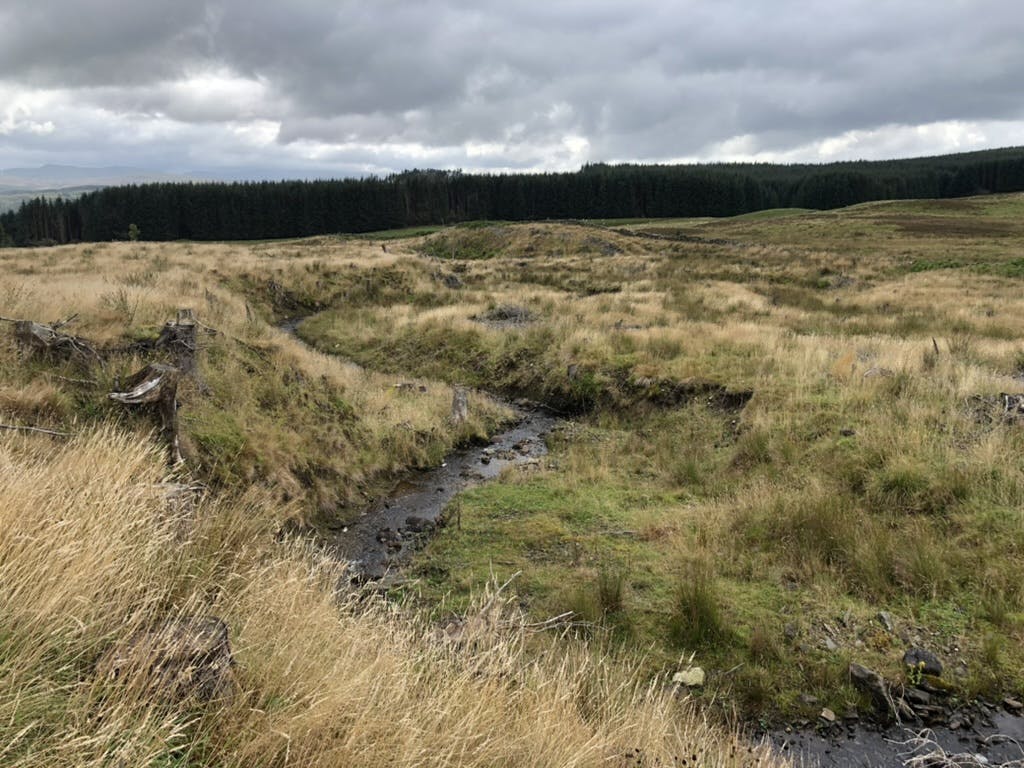
Project Risks and Mitigation
Firstly, there could be a delay to the construction of the BDAs if water levels are too high. Should this happen, we will postpone work until water levels subside. Secondly, to prevent the issue of deers browsing the newly planted trees, the trees will be planted in square exclosures of 4.8m. The small size of the exclosure is designed to deter any deer from jumping the fence into a small space.
A freshwater pearl mussel survey will also be conducted to detect the endangered species and inform if further monitoring is needed. However, the likelihood of detecting freshwater pearl mussels is low due to the site being above the main stem of the river where the water is steep. As freshwater pearl mussel larvae (called glochidia) travel on the gills of salmon or trout, if fish migration along the stream is not possible due to its steepness, we don't predict freshwater pearl mussels will be present either.
The team of biologists from River Revivers will ensure the BDAs are resilient. They will keep adding materials to reinforce the structures in much the same way beavers do to maintain their own dams. We do not expect them to be permanent however. We may need to build more BDAs to reach the desired outcome. Furthermore, the effectiveness of BDAs as bio-filters is often cited although not often researched. This project aims to contribute to the knowledge base on BDAs.
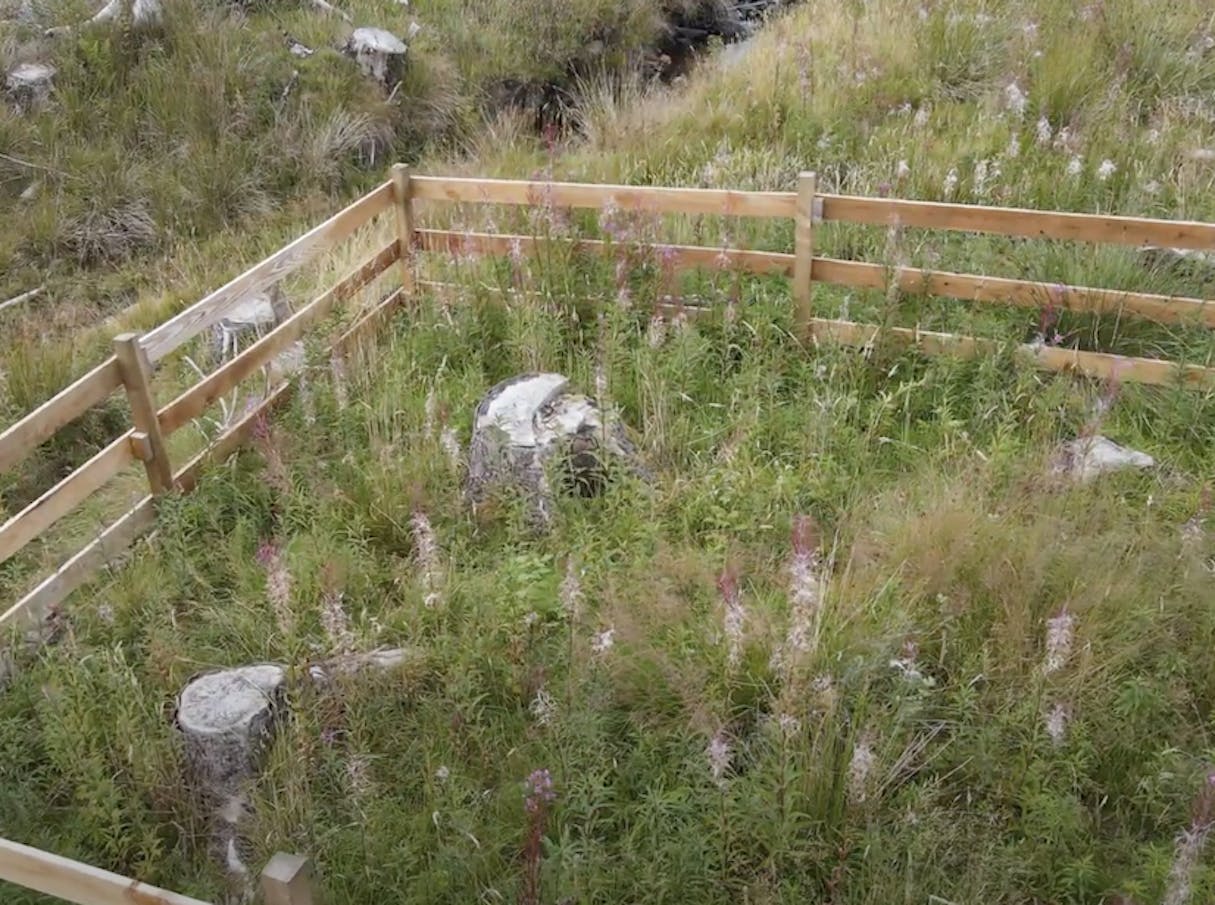
Monitoring and Reporting
Baseline surveys for the site will be carried out before the interventions begin. Data will be collected for water temperature, and ecological surveys will be conducted for otters and freshwater pearl mussels, fish and surrounding habitat. Read the baseline survey report here.
The water temperature will be monitored periodically every 5 years for 15 years to capture what we hope will be a reduction in water temperature as shade from the newly planted trees increases. No significant change in water temperature is expected between the baseline data and the first monitoring due to the trees still being quite small but the results should show greater differences as the trees grow. Riverfly species and their abundance will also be monitored as they are a good indicator of water quality and freshwater invertebrate abundance and diversity. This will happen at the start of the project, and at 6 monthly intervals for 2 years.
A progress report will be completed after the first year of the project to identify on-the-ground changes and to evaluate the success of the intervention.
This project presents a good opportunity to share knowledge and our experience to encourage similar works elsewhere. The team at River Revivers plan to instruct members of the NRN (Northwoods Rewilding Network) in how to build BDAs. This could lead to more BDAs being constructed on the land of NRN members.
We thank Mossy Earth members for funding this project and making it possible for us to trial BDAs at Glassie Farm where we anticipate positive changes to biodiversity.
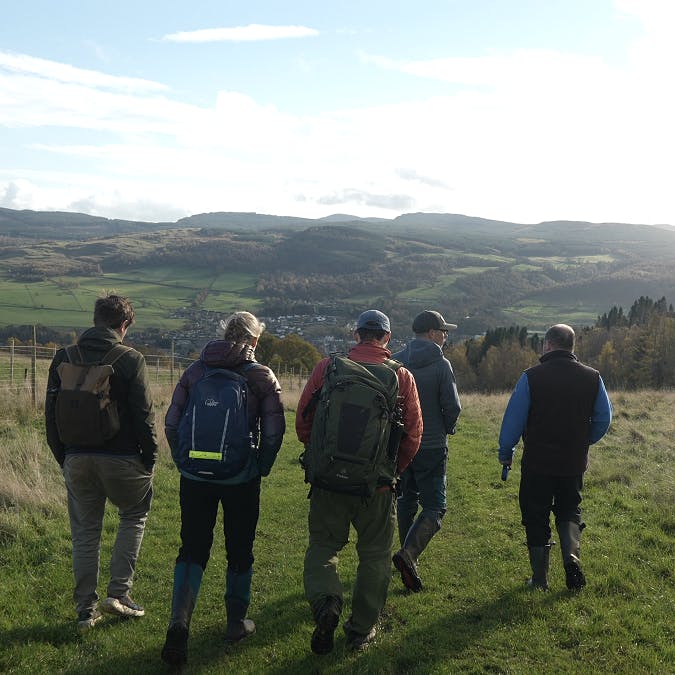

Installation of the Beaver Dam Analogues
the team behind the project

Ellie Jackson-Smith, Conservation Biologist, Mossy Earth

Duncan Pepper, Ecologist, River Revivers

Maja Pepper, Geomorphologist & Hydrologist, River Revivers
Sources & further reading

- “A Stream Evolution Model Integrating Habitat and Ecosystem Benefits” - B. Cluer, C. Thorne, 2013
- “The effect of beaver dams on organic carbon, nutrients and methyl mercury distribution in impounded waterbodies” - Wildlife Biology, 2020(3), (16 September 2020)
